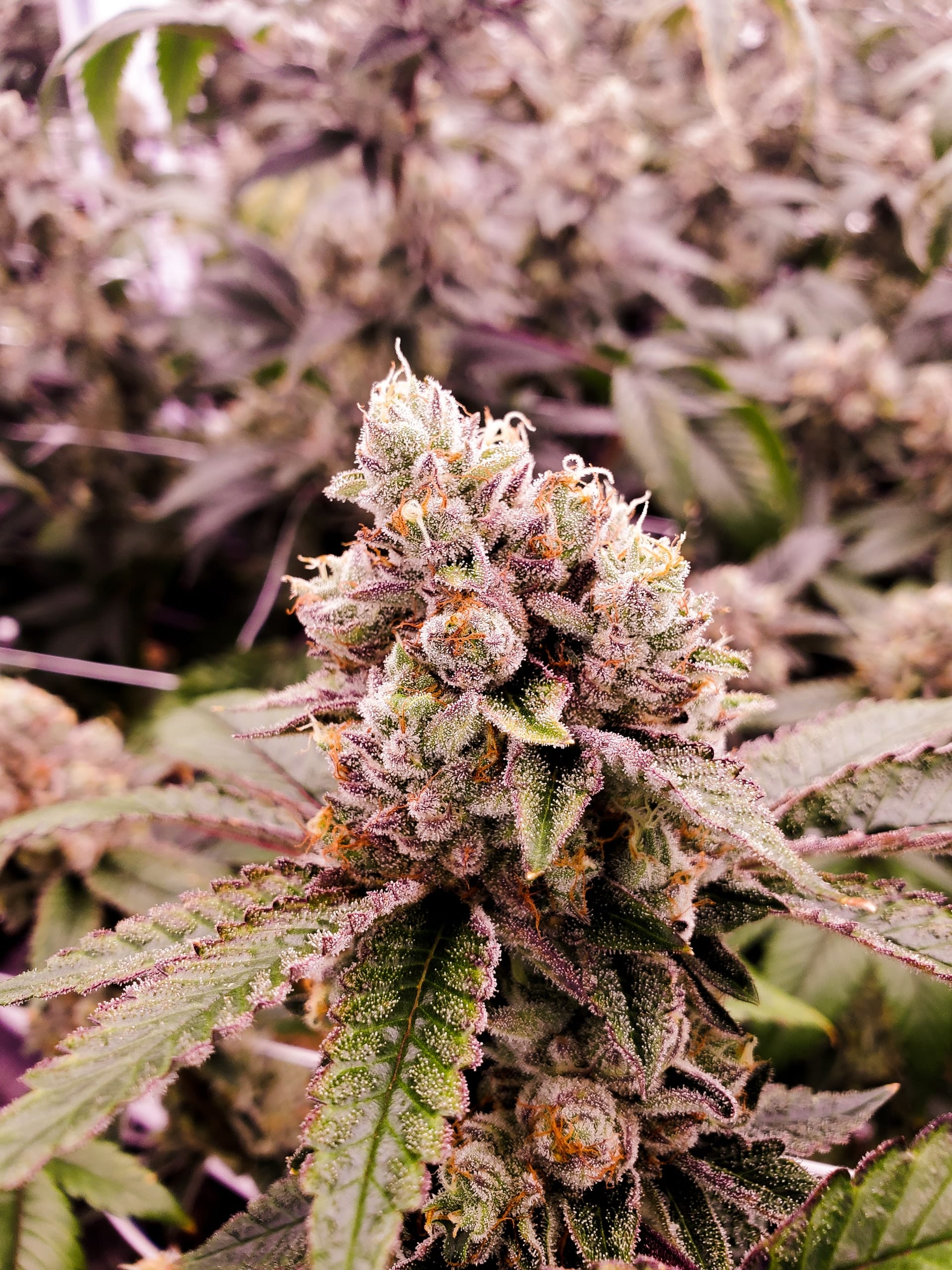Cannabinoids are a group of chemical compounds found naturally in cannabis that show significant effects on the human body. Among them is CBG (cannabigerol), which, although not as widely recognized as THC or CBD, is gaining increasing attention for its potential health benefits and therapeutic potential. In this article, we'll take a closer look at CBG - its definition, history of discovery, chemical structure and differences from other cannabinoids.
Definition and History of CBG Discovery:
CBG is one of more than 100 known cannabinoids found in the cannabis plant. It is the earliest cannabinoid to be synthesized, appearing in the young flower buds and leaves of the plant before it is transformed into other forms, such as THC (tetrahydrocannabinol) or CBD (cannabidiol).
The history of CBG's discovery dates back to the 1960s, when scientists first isolated it from cannabis. However, for a long time it remained in the shadow of more well-known cannabinoids such as THC and CBD. It is only in recent years that CBG has gained popularity, thanks to the growing interest in the medical potential of cannabis and the development of extraction technologies that allow more efficient extraction of this cannabinoid.
CBG Chemical Structure:
CBG is a chemical compound with a unique structure that differs from other cannabinoids. Its molecular formula is C17H25NO2, and its main structure is based on a triterpene skeleton, like other cannabinoids. However, CBG has an additional hydroxyl group (-OH) attached to the B ring, which gives it unique chemical and biological properties.
Compared to THC and CBD, CBG has a less complex chemical structure. For example, THC contains an additional cyclopentane ring, while CBD has a different double bond position in the side chain. These structural differences affect how CBG interacts with cannabinoid receptors, which in turn determines its pharmacological effects.
Occurrence in Nature and Methods of Acquisition:
CBG occurs naturally in cannabis, but its concentration is much lower than THC or CBD. It typically makes up less than 1% of the plant's dry weight, making it difficult and expensive to extract on a large scale.
CBG extraction methods include supercritical CO2 extraction and traditional solvent extraction methods such as acetone or alcohol extraction. Modern technologies allow more efficient extraction of CBG, however, it is still a process that requires advanced infrastructure and expertise.
CBG, although less well known than THC or CBD, is a fascinating and potentially beneficial substance in the world of cannabinoids. Its unique chemical structure and history of discovery underscore its role as one of the first isolated cannabinoids, and open up new opportunities for research into the medical and industrial uses of hemp. As science and technology continue to advance, CBG is poised to become a more important player in the hemp products market, offering new ways to support health and well-being.
We encourage readers to continue exploring the topic of CBG and its potential in medicine and the hemp industry. As our understanding of this substance evolves, we can expect new discoveries and innovations that will further enhance our ability to use CBG for the benefit of human health.
Cannabinoids are a group of chemical compounds found naturally in cannabis that show significant effects on the human body. Among them is CBG (cannabigerol), which, although not as widely recognized as THC or CBD, is gaining popularity for its potential health benefits. In this article, we'll take a closer look at CBG, its definition, history of discovery, chemical structure and differences from other cannabinoids.
Definition and History of CBG Discovery
Definition:
CBG, or cannabigerol, is one of the first cannabinoids discovered in hemp seed (Cannabis sativa). It is a precursor to other known cannabinoids, such as THC (tetrahydrocannabinol) and CBD (cannabidiol). Unlike these two compounds, CBG is found in hemp plants at a very early stage of development.
History of Discovery:
The cannabinoids were first mentioned as early as the 1940s, when scientists began studying the cannabis plant for potential medicinal uses. CBG was identified as one of the key cannabinoids in 1964 by Israeli chemist Raphael Mechoulam, who also discovered THC and CBD. Since then, CBG has remained in the shadow of its more famous cousins until recent years, when interest in cannabinoids began to grow worldwide.
Chemical Structure and Differences from Other Cannabinoids
Chemical Structure:
CBG, like other cannabinoids, belongs to a group of organic compounds called terpenophenones. Its chemical structure is based on a benzene ring linked to two side chains. The main difference between CBG and THC and CBD is the presence of additional functional groups and the arrangement of carbon atoms, which gives it unique chemical properties.
Differences in Relationship to THC and CBD:
- THC: CBG differs from THC primarily in the presence of a hydroxyl group (-OH) at the benzene ring, which affects its psychoactive activity. Unlike THC, CBG does not exhibit hallucinogenic effects or disturbance of sensory perception.
- CBD: CBG and CBD have similar structures, but they differ in the presence of an additional side chain in the case of CBD and the absence of a hydroxyl group at the benzene ring in CBG. These differences determine their interactions with the body's endocannabinoid system and their effects on health.
Despite being less well-known than THC and CBD, CBG has unique properties that make it a promising candidate for further scientific research. Its chemical structure suggests the potential for use in treating a variety of health conditions, from neurodegenerative diseases to skin problems and inflammation. Although CBG still remains in the shadow of its more popular "cousins," its potential is undeniable, and the future may bring new discoveries that will further advance our knowledge of this fascinating substance.
CBG - The Fascinating Substance of Hemp: Action and Mechanism of Action
Mechanism of action of CBG on the endocannabinoid system:
The endocannabinoid system (ECS) is a complex communication system within the body that is responsible for regulating many physiological processes. CBG interacts with this system through cannabinoid receptors (CB1 and CB2), which are mainly found in the brain and peripheral nervous system, but also in other tissues.
CB1 receptors are located primarily in neurons and glial cells in the brain, and their activation leads to changes in the functioning of synapses and neurotransmission. CB2 receptors, on the other hand, are located primarily on the surface of immune cells, such as T lymphocytes, macrophages and monocytes, where they regulate inflammatory and immune processes.
Anti-inflammatory effects of CBG:
One of the most promising aspects of CBG is its ability to reduce inflammation in the body. Studies in animal models have shown that CBG can inhibit the production of pro-inflammatory cytokines such as TNF-α and IL-1β, which are key in inflammatory processes. In addition, CBG can stimulate the synthesis of endocannabinoids and anandamide, which further contributes to the modulation of inflammation.
Potential applications in the treatment of neurodegenerative diseases:
CBG shows interesting properties that may be useful in the fight against neurodegenerative diseases such as Alzheimer's and Parkinson's. Studies on nerve cells suggest that CBG may inhibit processes leading to neuronal loss and reduce oxidative stress in the brain. In addition, CBG appears to have antioxidant and anti-inflammatory effects, which may help protect nerve cells from damage.
Effects on the immune system:
CBG also has the potential to modulate the immune system. It can inhibit excessive activity of immune system cells, which may be beneficial in autoimmune diseases and in alleviating allergic reactions. In addition, CBG can promote wound healing and tissue regeneration, which is promising for treating skin injuries and diseases.
Safety of CBG use:
Although CBG is a natural plant-derived compound, potential interactions with other drugs and possible side effects should be kept in mind. Studies to date indicate that CBG has low toxicity, but further research is needed to fully understand its safety profile.
Summary and future prospects:
CBG remains a cannabinoid with tremendous therapeutic potential that is still being studied for its effects on the human body. Its ability to modulate inflammation, support the immune system and have neuroprotective effects make it a promising candidate for the treatment of many conditions. Although CBG is currently less understood than THC and CBD, its role in medicine may increase significantly in the future.
CBG is a cannabinoid that deserves the attention of both scientists and patients seeking new treatment options. Its unique properties and potential applications open up new possibilities in the treatment of inflammatory diseases, neurodegenerative diseases and other health conditions. As research on CBG continues, we can expect to gain a better understanding of its actions and mechanisms, which will bring even greater benefits to human health.
CBG in Medicine: New Horizons of Treatment and Health
CBG, or cannabigerol, is a cannabinoid derived from cannabis (Cannabis indica) with growing importance in medicine. Its discovery and research into its effectiveness are opening up new perspectives for treating a variety of conditions. In this article, we'll take a closer look at CBG's medical applications, its effects on health and potential therapeutic possibilities.
Analgesic effects of CBG
One of the best-documented actions of CBG is its potential in relieving pain. Studies indicate that CBG can block the ion channels responsible for transmitting pain signals to the brain. This mechanism makes CBG likely to be effective in treating conditions such as:
- Neuropathic pain
- Post-traumatic pain
- Chronic pain
Effects on the immune system
CBG has been shown to modulate the body's immune response. Studies suggest that it may have anti-inflammatory and antioxidant effects, making it a promising agent for treating inflammatory diseases such as:
- Autoimmune diseases (such as rheumatoid arthritis)
- Dermatitis
- Inflammatory bowel disease
Support for mental health
CBG may also have positive effects on mental health. Studies indicate that this cannabinoid can:
- Reduce anxiety and depressive states
- Improve sleep quality
- Reduce stress-related symptoms
Its effects can be particularly beneficial for people suffering from: - Anxiety disorders
- Depression
- Mental illnesses coexisting with pain
Potential applications in cancer treatment
Although more research is needed, CBG appears to have the potential to inhibit cancer cell growth and reduce cancer-related inflammation. These mechanisms could lead to better performance of cancer therapy and reduce the side effects of chemotherapy.
Safety of CBG use
Although CBG is generally considered safe, it is important to be aware of potential interactions with other medications and possible side effects. It's always a good idea to consult your doctor before starting CBG therapy, especially if you are taking other medications or have a chronic illness.
The future of CBG research
Research on CBG is still ongoing, and every year we discover new possibilities for this cannabinoid. As scientific progress continues, we can expect to see more and more advanced CBG-based treatments that will bring relief and improve the quality of life for many patients.
CBG is a promising cannabinoid with a wide range of potential medical applications. From pain relief and immune system support to improved mental health and potential benefits in cancer treatment, CBG is poised to become an important part of the therapeutic arsenal of the future. However, it is worth emphasizing that further research is needed to fully understand and harness the potential of this natural cannabis ingredient.
The digestive tract is a key component of our health, and its proper functioning affects the overall health of the body. In recent years, more and more attention has been paid to natural remedies that support digestive health, and one of the most promising is a cannabinoid known as CBG - cannabigerol. In this article, we'll take a closer look at its effects on the digestive system and the potential benefits it can bring in treating various gastrointestinal disorders
CBG: What is it and where does it come from?
CBG (cannabigerol) is a natural cannabinoid found in cannabis (Cannabis indica). It is one of the most important precursors of other cannabinoids, such as THC and CBD. CBG is present in the plant throughout its life, but its concentration changes over time - it peaks during the flowering stage.
Why can CBG be helpful for the digestive system?
The digestive system is one of the most complex systems in the human body. It is subject to the influence of various external and internal factors that can lead to a variety of disorders. CBG can have a positive impact on the health of the digestive tract due to several key properties:
- Anti-inflammatory effects: Many gastrointestinal conditions, such as Crohn's disease and ulcerative colitis, are associated with inflammation. CBG can reduce inflammatory processes by blocking pro-inflammatory enzymes and promoting the production of anti-inflammatory cytokines.
- Antimicrobial properties: The digestive system is home to a diverse bacterial flora, which plays a key role in maintaining health. CBG can have an antimicrobial effect, which helps fight infections and balance the gut microflora.
- Effects on intestinal motility: Some people experience problems with gastrointestinal motility, such as constipation or diarrhea. CBG can regulate this function by interacting with cannabinoid receptors in the intestinal nervous system.
- Protecting the mucosal barrier: The mucosal barrier lining the gastrointestinal tract is susceptible to damage, which can lead to the development of inflammatory diseases. CBG can help protect this barrier, which contributes to better gastrointestinal function.
Research on the effects of CBG on the digestive system
Research on the effects of CBG on the digestive system is still in progress, but the first results are promising:
- In vitro: In laboratory studies, CBG has been shown to have the ability to inhibit the growth of pathogenic bacteria, such as Staphylococcus aureus and Salmonella typhimurium, and reduce the production of pro-inflammatory cytokines.
- On animals: In animal models, CBG has been shown to have analgesic, anti-inflammatory and immunomodulatory effects, suggesting potential benefits in the treatment of gastrointestinal disorders.
- Clinical trials: Although human studies are limited, there are reports of positive effects of CBG in treating symptoms of irritable bowel syndrome and other gastrointestinal diseases.
How to use CBG for digestive health?
CBG is available in various forms, such as oils, capsules, ointments and food products. To take advantage of its potential benefits for the digestive system, it is important to use the right dose and form:
- CBG oil: This is the most commonly used form due to its ease of access and ability to dose precisely. It is recommended to start with low doses, such as 5 mg per day, and then gradually increase depending on the body's tolerance.
- Capsules: They are a convenient form of CBG administration and allow precise dosage. It is important to choose high-quality products without chemical additives and with the right concentration of cannabinoids.
- Food products: Many companies offer foods containing CBG, such as teas, drinks and snacks. However, it is important to note that absorption of cannabinoids through the gastrointestinal tract may be less efficient than through the oral or sublingual route.
CBG and safety and side effects
Although CBG is considered relatively safe, like any cannabinoid, it can cause some side effects. Among the most commonly reported are fatigue, dry mouth and dizziness. It is important to consult a doctor before starting CBG, especially if you are taking other medications or have existing health problems.
CBG has shown potential in treating and supporting gastrointestinal function, including reducing inflammation, protecting the mucosal barrier and regulating intestinal motility. Although research is still limited, initial results are promising and suggest the possibility of using CBG to complement traditional treatments for gastrointestinal diseases. However, it is worth remembering to consult a doctor before starting to use this cannabinoid.
Synergy of Action of CBG with CBD and THC: How Interactions Between Cannabinoids Enhance the Therapeutic Potential of Cannabis.
Rich in a variety of cannabinoids, hemp offers a wide range of potential health benefits. Of these, CBG (Cannabigerol), CBD (Cannabidiol) and THC (Tetrahydrocannabinol) stand out as key components with promising therapeutic properties. In this article, we take a look at how the synergistic effects of these three cannabinoids can enhance their individual therapeutic effects, and how the interactions between them can open up new horizons in medical therapy.
CBG - An Unexpected Giant in the World of Cannabinoids.
CBG is less well known than CBD and THC, but research in recent years reveals its promising potential for treating a variety of conditions. CBG exhibits anti-inflammatory, antimicrobial effects and may be particularly beneficial for the immune and digestive systems.
CBD - the Main Hero in the World of Cannabinoids.
CBD, known as the main ingredient in cannabis, is widely researched for its antioxidant, anti-anxiety and analgesic effects. CBD has no psychoactive effects, making it an attractive remedy for many users seeking natural treatments.
THC - the Controversial King of Cannabinoids.
THC is the main psychoactive ingredient in cannabis and is responsible for the characteristic "intoxication" of marijuana. Although THC has less understood health benefits than CBD, research suggests its potential for treating neuropathic pain, chemotherapy-induced nausea and muscle spasticity.
Synergy of Action - CBG and CBD in Action
CBG and CBD, acting together, can enhance their individual effects through synergistic interactions. For example, CBG can enhance the anti-inflammatory effects of CBD, while CBD can reduce the potentially adverse side effects caused by CBG.
CBG and THC - A Dangerous Romance?
Interactions between CBG and THC are less studied, but there are indications suggesting that they may also enhance each other's effects. Although THC is the main psychoactive ingredient, CBG may modulate its effects, reducing potential adverse psychological sensations.
Research on Action Synergy - What We Know and What We Don't Yet Know
Research into the synergistic effects of CBG with CBD and THC is still ongoing, but initial results are promising. Future studies may provide more information on the optimal proportions of these cannabinoids and their potential use in treating a variety of conditions.
Practical Application of Synergy of Action - How to Harness the Potential of CBG, CBD and THC?
Although research is still limited, there are already products containing blends of these cannabinoids. Users can experiment with different ratios in search of the optimal combination for their individual health needs.
Safety and Long-Term Effects - What Should You Know?
While the synergistic effects of CBG, CBD and THC offer promising therapeutic possibilities, it is important to be aware of the potential risks and long-term effects of using these cannabinoids. Consultation with a doctor or specialist is key before starting any cannabis therapy.
The synergistic effects of CBG, CBD and THC are opening up new possibilities in the medical use of cannabis. Interactions between these cannabinoids may enhance their individual health benefits, offering more effective and safer therapies for a range of conditions. Although research is still ongoing, early results are promising and suggest that hemp could become an important tool in the treatment of the future.








